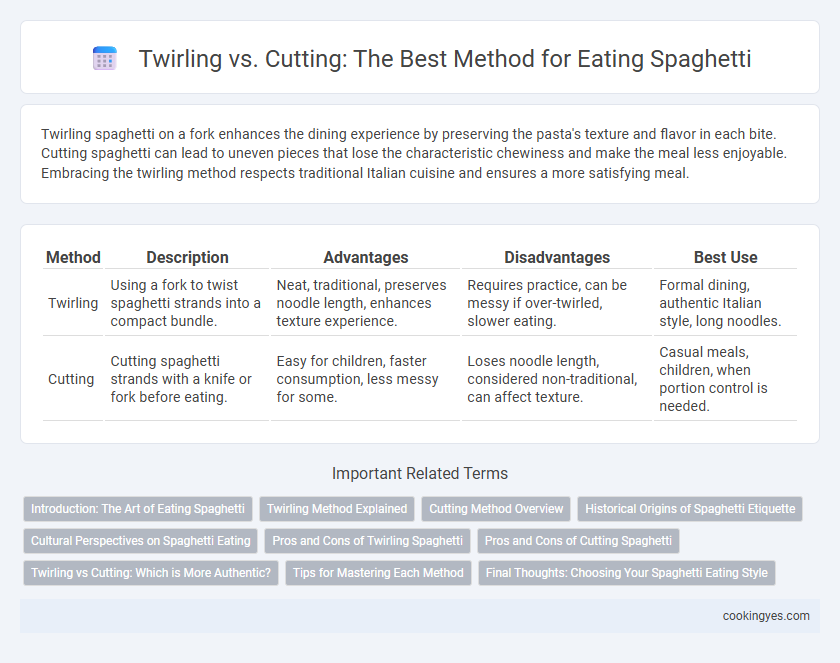Twirling spaghetti on a fork enhances the dining experience by preserving the pasta's texture and flavor in each bite. Cutting spaghetti can lead to uneven pieces that lose the characteristic chewiness and make the meal less enjoyable. Embracing the twirling method respects traditional Italian cuisine and ensures a more satisfying meal.
Table of Comparison
| Method | Description | Advantages | Disadvantages | Best Use |
|---|---|---|---|---|
| Twirling | Using a fork to twist spaghetti strands into a compact bundle. | Neat, traditional, preserves noodle length, enhances texture experience. | Requires practice, can be messy if over-twirled, slower eating. | Formal dining, authentic Italian style, long noodles. |
| Cutting | Cutting spaghetti strands with a knife or fork before eating. | Easy for children, faster consumption, less messy for some. | Loses noodle length, considered non-traditional, can affect texture. | Casual meals, children, when portion control is needed. |
Introduction: The Art of Eating Spaghetti
Mastering the art of eating spaghetti involves understanding the subtle differences between twirling and cutting methods, each impacting texture and flavor perception. Twirling spaghetti on a fork preserves the noodle's integrity, enhancing the sauce's adherence and delivering a balanced taste experience. Cutting spaghetti, while quicker, can disrupt the noodle's structure and dilute the rich combination of pasta and sauce with each bite.
Twirling Method Explained
The twirling method for eating spaghetti involves using a fork to gather a small portion of pasta strands and rotating them against the plate or a spoon to form a neat bundle. This technique enhances the eating experience by preventing sauce splatter and allowing better control of bite-sized portions. Twirling preserves the texture and flavor balance, making it the preferred method among culinary experts.
Cutting Method Overview
The cutting method for eating spaghetti involves using a knife and fork to slice the pasta into manageable pieces, preventing the noodles from slipping and reducing mess. This approach is especially practical for shorter or more rigid spaghetti varieties and helps maintain portion control. While less traditional than twirling, cutting can provide a cleaner, more controlled dining experience for those who prefer it.
Historical Origins of Spaghetti Etiquette
Spaghetti twirling as a traditional eating method dates back to Italian dining customs in the 19th century, where using a fork alone was considered the proper way to avoid making a mess. Cutting spaghetti was often viewed as a violation of Italian table manners, rooted in the etiquette of preserving the pasta's long strands to honor the craftsmanship of its preparation. Historical etiquette guides from Italy emphasize twirling as the elegant technique, reflecting cultural values and the significance of pasta in Italian culinary heritage.
Cultural Perspectives on Spaghetti Eating
Twirling spaghetti with a fork is widely regarded as the traditional Italian method, emphasizing elegance and cultural authenticity in pasta consumption. In contrast, cutting spaghetti is more common in certain Western cultures, reflecting practicality and different dining etiquette preferences. These diverse approaches highlight how cultural norms shape the experience and etiquette of eating spaghetti across the world.
Pros and Cons of Twirling Spaghetti
Twirling spaghetti offers a cleaner and more traditional eating experience by neatly gathering strands onto a fork, reducing sauce splatter and mess. This method enhances portion control but may require practice to avoid awkwardness or excessive effort with long noodles. However, twirling can slow eating speed and is less practical in informal settings where cutting spaghetti might be preferred for convenience.
Pros and Cons of Cutting Spaghetti
Cutting spaghetti reduces the risk of messy splattering and makes it easier for children and elderly individuals to eat, but it compromises the traditional dining experience by altering the texture and flavor balance. It also shortens cooking time requirements and can help manage portion control, though it may lead to uneven sauce distribution on smaller pasta pieces. While cutting enhances convenience, it diminishes the authentic enjoyment of spaghetti's long, twirlable strands that hold sauce effectively on the surface.
Twirling vs Cutting: Which is More Authentic?
Twirling spaghetti with a fork on a plate or against a spoon is traditionally considered the most authentic Italian method, preserving the pasta's texture and enhancing flavor absorption. Cutting spaghetti into smaller pieces is often seen as less authentic and can disrupt the intended eating experience by altering the pasta's structure. Culinary experts and Italian dining etiquette consistently favor twirling for maintaining the dish's authenticity and enjoyment.
Tips for Mastering Each Method
Twirling spaghetti with a fork requires steady wrist movement and a small plate or spoon to aid in gathering strands neatly, ensuring that the pasta clumps without splashing sauce. Cutting spaghetti, although less traditional, demands a sharp knife and firm control to create manageable bite-sized pieces, ideal for children or those preferring smaller portions. Mastery of either method hinges on practice to balance efficiency and etiquette, enhancing the overall dining experience.
Final Thoughts: Choosing Your Spaghetti Eating Style
Twirling spaghetti around a fork preserves the noodle's texture and enhances the flavor experience by combining sauce and pasta in each bite. Cutting spaghetti pieces breaks the long strands, often resulting in a less authentic dining experience and potentially uneven sauce distribution. Select the method that best suits your comfort and enjoyment, balancing etiquette with personal preference for an optimal spaghetti meal.
Twirling vs Cutting for Spaghetti Eating Method Infographic

 cookingyes.com
cookingyes.com